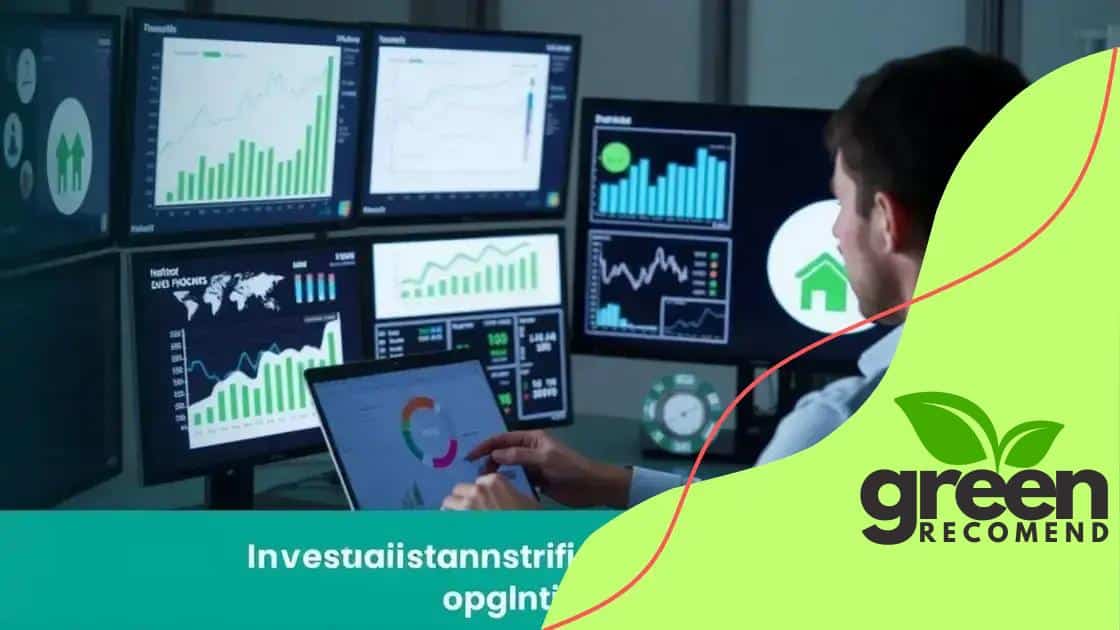How to incorporate sustainability into your investment approach

Incorporating sustainability into your investment approach enhances financial returns while positively impacting society and the environment through strategic selection and measurement of ESG criteria.
How to incorporate sustainability into your investment approach is increasingly becoming a priority for conscientious investors. Have you thought about how your choices can influence both your portfolio and the planet? Let’s delve into why this matters.
Understanding sustainable investments
Understanding sustainable investments is crucial for anyone looking to align their financial goals with ethical values. By making informed choices, investors can contribute positively to environmental and social issues while still working towards financial growth.
What Are Sustainable Investments?
Sustainable investments consider not only financial returns but also the impact on society and the environment. This approach allows investors to support companies and initiatives that align with their values.
Types of Sustainable Investments
- Socially Responsible Investing (SRI): Focuses on companies with ethical practices.
- Environmental, Social, and Governance (ESG) Investing: Evaluates companies based on specific criteria.
- Impact Investing: Aims for measurable social or environmental benefits alongside financial returns.
- Green Bonds: Financial instruments supporting environmentally friendly projects.
A growing number of investors are recognizing the benefits of incorporating sustainability into their portfolios. Not only can this lead to potential financial gains, but it can also create a positive impact on the world. The concept is gaining traction, driven by consumer demand for responsible practices.
Investors are increasingly examining companies’ sustainability practices before making decisions. Research shows that companies with strong ESG performance often outperform their peers in the long run. This trend suggests that sustainability can drive profitability.
Moreover, tools and resources are available to help investors assess the sustainability of their options. Many financial institutions now offer funds that prioritize sustainability, making it easier for anyone to get started.
The Future of Investing
As the world becomes more aware of environmental and social issues, the future of investing is undeniably heading towards sustainability. The shift from traditional to sustainable investing reflects a broader societal change towards accountability and responsibility.
By understanding sustainable investments and making informed choices, you can play a part in shaping a better future for both your finances and the world.
Benefits of sustainability in investing
The benefits of sustainability in investing are becoming more evident as individuals and organizations seek to make a positive impact while achieving their financial goals. Investors are increasingly drawn to sustainable strategies for a variety of compelling reasons.
Financial Performance
A key benefit of sustainable investing is the potential for strong financial performance. Studies have shown that companies with robust environmental, social, and governance (ESG) practices often outperform their peers over time. This indicates that sustainability can lead to better returns on investments.
Risk Mitigation
Investing in sustainable companies can also help mitigate risks. These organizations are typically more resilient, as they focus on long-term viability. They are less likely to face regulatory penalties, reputational damage, or other risks associated with unsustainable practices.
- Lower volatility in investments.
- Better management of long-term risks.
- Alignment with consumer trends toward responsible choices.
- Increased demand for sustainable products and services.
Furthermore, sustainable investments often align investors with ethical practices. This alignment fosters a sense of purpose and satisfaction, knowing their money supports companies that make a positive difference.
As social consciousness grows, businesses that prioritize sustainability appeal more to consumers. This trend can enhance customer loyalty and market competitiveness, resulting in improved sales and profitability.
Positive Impact on Society
By choosing sustainable investments, investors can contribute to addressing global challenges such as climate change, inequality, and resource depletion. Investments in clean energy or affordable housing not only generate returns but also support initiatives that benefit society.
This strategy resonates deeply with millennials and younger investors who often prioritize values in their financial decisions. Such a focus not only drives personal financial growth but also creates a collective impact towards a more sustainable future.
Identifying sustainable investment opportunities

Identifying sustainable investment opportunities is essential for investors seeking to align their portfolios with their values. Knowing where to look and how to evaluate these opportunities can make a significant difference in achieving both financial returns and positive impact.
Researching Potential Investments
Start by researching companies that prioritize sustainability in their operations. Look for organizations that actively promote environmentally friendly practices and social responsibility. This helps ensure your money supports those making a difference.
Using ESG Scores
Many investors use environmental, social, and governance (ESG) scores to evaluate potential investments. These scores provide insight into how well companies perform in key areas. High ESG scores often indicate that a company is a good candidate for sustainable investment.
- Access reputable financial websites for ratings.
- Check for third-party research reports on companies.
- Look for sustainability certifications or awards.
Another approach is to explore mutual funds or exchange-traded funds (ETFs) focused on sustainability. These funds typically include a variety of companies that meet specific sustainability criteria, making it easier to diversify your investments.
Networking with like-minded investors can also help you identify sustainable opportunities. Engaging in discussions within investment communities or forums can expose you to new ideas and insights that you might not find through traditional research.
Staying Updated on Trends
Being aware of current trends in sustainability can guide your investment choices. Focus on emerging sectors, such as renewable energy, green technology, and sustainable agriculture. These areas are gaining traction and often present exciting opportunities for growth.
Additionally, keep an eye on government policies and initiatives promoting sustainability. Investments in projects supported by government incentives can help mitigate risks associated with financial returns.
By effectively identifying sustainable investment opportunities, you can enhance both the impact of your investments and the potential for financial gains.
Strategies for integrating sustainability
Integrating sustainability into your investment strategy can enhance both financial returns and positive impact on society. By adopting practical approaches, you can align your portfolio with your values effectively.
Define Your Sustainability Goals
The first step is to define your sustainability goals clearly. Knowing what you want to achieve will guide your investment decisions. Consider factors such as environmental impact, social responsibility, and corporate governance in your goals.
Diverse Investment Options
Utilizing a diverse range of investment options is also essential. Explore different asset classes, including stocks, bonds, and mutual funds focused on sustainability. Diversifying helps spread risk while supporting various sustainable initiatives.
- Invest in green technology.
- Consider renewable energy projects.
- Support socially responsible companies.
- Engage in impact investing.
Another effective strategy is to conduct diligent research before investing. This involves analyzing company practices, understanding their commitment to sustainability, and ensuring they align with your investment philosophy. Look for companies that actively promote sustainability, reducing their environmental footprint and contributing positively to society.
Engage with Companies
Engaging with companies you invest in can further promote sustainability. Shareholder engagement allows you to influence corporate policies, encouraging greater accountability and transparency. Attend annual meetings, ask questions, and voice your expectations regarding sustainability efforts.
Additionally, consider leveraging technology to track and analyze your investments’ sustainability. Many platforms provide tools that allow you to assess the social and environmental impact of your portfolio in real time.
Stay Informed on Trends
Staying informed about trends in sustainability is vital for integrating these strategies effectively. As new technologies and practices emerge, be ready to adapt your investment approach to meet evolving standards and expectations in sustainability.
By implementing these strategies for integrating sustainability, you can build a portfolio that not only aims for strong financial returns but also supports a healthier planet and society.
Measuring the impact of sustainable investments
Measuring the impact of sustainable investments is essential for understanding how your financial choices affect the world. Investors want to know not just the returns but also the social and environmental benefits of their investments.
Understanding Key Metrics
To effectively measure impact, start by learning about key metrics used to assess sustainability. Common metrics include carbon footprint reduction, energy efficiency improvements, and social equity advancements. Each of these metrics can provide insights into how investments contribute to sustainability goals.
Utilizing Reporting Frameworks
Numerous reporting frameworks can help you evaluate the impact of your investments. Frameworks like the Global Reporting Initiative (GRI) and the Sustainability Accounting Standards Board (SASB) set standards for transparency and accountability in sustainability reporting.
- Analyze metrics related to environmental impact.
- Consider social outcomes of investments.
- Review governance practices within companies.
Investors should also look for third-party evaluations that provide independent assessments of a company’s sustainability performance. Such evaluations can add credibility and trust to the information. Active engagement with companies about their sustainability practices can yield valuable insights, enhancing your understanding of their impact.
Aligning Goals with Measurement
It’s vital to align your sustainability goals with measurable outcomes. Define what success looks like for your investments, whether it’s reducing carbon emissions or promoting social initiatives. This alignment helps ensure that your investment strategy reflects your values and desired impact.
Regularly reviewing and adjusting your investment portfolio based on measured impact can further enhance the effectiveness of your strategies. This practice ensures that you remain focused on achieving your sustainability objectives as the market evolves.
Impact on Financial Performance
It’s important to note that measuring impact should not only focus on ethical considerations but also financial performance. Numerous studies indicate that companies with strong sustainability initiatives often exhibit higher profitability and lower volatility.
By measuring the impact of sustainable investments, you gain insight into how your financial decisions contribute to a better world while still aiming for rewarding financial outcomes.
FAQ – Frequently Asked Questions about Sustainable Investments
What are sustainable investments?
Sustainable investments are financial assets that are chosen based on their positive impact on the environment, society, and governance.
Why should I consider sustainable investing?
Sustainable investing not only aligns with ethical values but can also lead to strong financial performance and reduced risks.
How can I measure the impact of my sustainable investments?
You can measure impact by using key metrics, reporting frameworks, and third-party evaluations to assess environmental and social outcomes.
What strategies can I use to integrate sustainability into my portfolio?
You can set clear sustainability goals, research diverse investment options, and engage with companies regarding their sustainable practices.





